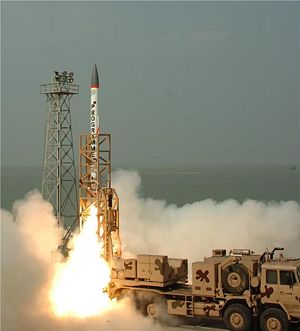On May 15, India successfully conducted a test of its indigenously designed ballistic missile defense system on Abdu Kalam Island off the coast of Odisha in the Bay of Bengal and home to the Integrated Test Range, the Indian military’s primary missile test facility, The Economic Times reports.
The test involved the launch of the single-stage Ashvin Advanced Defense interceptor missile from a mobile launcher at 11:15am local time and the successful destruction of an incoming nuclear-capable Dhanush ballistic missile at endo-atmospheric altitudes of 20-40 kilometers.
The Dhanush was launched from an Indian Navy vessel in the Bay of Bengal. The Dhanush is a naval variant of the Prithyi III tactical surface-to-surface short-range ballistic missile and has an approximate range of 350 kilometers (217 miles).
“The ‘kill’ effect of the interceptor was ascertained by analyzing data from multiple tracking sources,” a Defense Research Development Organization (DRDO) scientist explained. “The test conducted to validate various parameters of the interceptor in flight mode has been successful,” he added.
India began developing a multi-tiered ballistic missile defense (BMD) system in 1999, after the end of the Kargil War in reaction to Pakistan’s growing missile arsenal. A consortium of 40 Indian companies were involved in the development of the missile defense shield.
India’s BMD shield is a two-tiered defense system with the Prithvi Air Defense (PAD) / Pradyumna Ballistic Missile Interceptor destroying missiles at exo-atmospheric altitudes of 50–80 kilometers (31–50 miles), and the Advanced Air Defense (AAD)/ Ashvin Advanced Defense interceptor missile endo-atmosphere at altitudes of 20-40 kilometers (12-24 miles).
As The Diplomat previously noted:
If the PAD system is devised for mid-course interception, the AAD is a terminal phase interception system which can only counter incoming missiles after their entry into the atmosphere. In their present configuration, these systems are designed to counter missiles with range close to 2,000 kilometers [1242 miles] traveling at speeds ranging from Mach 3 to Mach 8.
India has been testing its BMD system repeatedly since 2007 with various degrees of success. While the May 15 test has been heralded as a milestone by the Indian media, it is important to realize that it says very little about the genuine capabilities of the system to intercept incoming missiles in a combat environment.
In addition to the indigenously developed BMD system, India has also procured six regiments of Russian S-300 air defense systems and is currently negotiating the acquisition of five regiments of more advanced S-400 air-defense systems with Russia. The induction of S-300 and S-400 regiments is meant as a stopgap measure to protect India’s major cities from missile attacks until the indigenously designed BMD system will be fully operational.
Pakistan reacted to the May 15 test with concern, saying that the test will disturb the balance of power in the region. A senior Pakistani official also said that Pakistan will raise the issue at the international level.
“Pakistan will raise its voice at the international level against these developments by India,” said Adviser to the Prime Minister on Foreign Affairs Sartaj Aziz, according to Radio Pakistan. “Pakistan will definitely acquire advanced technology to improve its defense.”

































